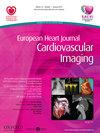Prospective validation of a non-invasive method to estimate myocardial work in aortic stenosis
引用次数: 0
Abstract
Type of funding sources: Public hospital(s). Main funding source(s): ANR - Maestro project Stratification of aortic stenosis patients remains challenging and robust indices are required. Myocardial work assessment is a new afterload independent alternative to evaluate left ventricular function. Although, this method was developed in patients with normal aortic valve. We previously developed an integrated cardiovascular system simulated by a computational model to estimate non-invasively myocardial work in aortic stenosis patients* (figure 1A). In the present study, we tested our model in a prospective population of AS patients. 9 patients with severe AS (aortic valve area < 1cm2) were included. A complete trans-thoracic echocardiography with a non-invasive blood pressure by brachial artery cuff were realized immediately before a left heart catheterization to have an invasive left ventricular pressure. Myocardial work is then calculated with non-invasive and invasive LV pressure combined to LV strain curves. For constructive and wasted work, root mean squared between invasive and estimated measures were respectively r2 = 0.92 and r2 = 0.94 (figure 1B) The proposed model is efficient to estimate non-invasively myocardial work indices in AS-patients. These afterload independent indices could permit in future to better stratify this population. *Owashi KP, Hubert A and al. Model-based estimation of left ventricular pressure and myocardial work in aortic stenosis. PlosOne 2020. Mar 3;15(3):e0229609 Abstract Figure 1一种评估主动脉狭窄患者心肌工作的无创方法的前瞻性验证
资金来源类型:公立医院。主动脉瓣狭窄患者的分层仍然具有挑战性,需要可靠的指标。心肌功评估是一种新的后负荷独立评价左心室功能的方法。虽然,这种方法是在正常主动脉瓣患者中发展起来的。我们之前开发了一个综合心血管系统,通过计算模型模拟,以估计主动脉瓣狭窄患者的非侵入性心肌工作*(图1A)。在目前的研究中,我们在一群AS患者中测试了我们的模型。重度AS(主动脉瓣面积< 1cm2)患者9例。在左心导管插管前,完成经胸超声心动图和肱动脉袖带无创血压测量,以获得有创左心室压力。然后通过无创和有创左室压力结合左室应变曲线计算心肌功。对于建设性功和浪费功,有创测量和估计测量的均方根分别为r2 = 0.92和r2 = 0.94(图1B)。本文提出的模型可以有效地估计as患者的无创心肌功指标。这些后负荷独立指数可以使将来更好地对这一人群进行分层。* wowashi KP, Hubert A,等。基于模型的主动脉瓣狭窄左室压和心肌功能评估。PlosOne 2020。3;15(3):e0229609
本文章由计算机程序翻译,如有差异,请以英文原文为准。
求助全文
约1分钟内获得全文
求助全文

 求助内容:
求助内容: 应助结果提醒方式:
应助结果提醒方式:


